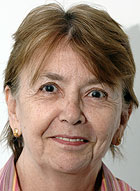In contrast to claims that children are being overmedicated for attention-deficit/hyperactivity disorder (ADHD), School of Medicine researchers have found that many kids with ADHD are not receiving treatment.
In fact, almost half of the children — within a 1,610-member study group — who might have benefited from ADHD drugs were not getting them.

“What we found was somewhat surprising,” said Richard D. Todd, M.D., Ph.D., the Blanche F. Ittleson Professor of Psychiatry and professor of genetics. “Only about 58 percent of boys and about 45 percent of girls who had a diagnosis of full-scale ADHD got any medication at all.”
Much has been written about the increasing number of children taking drugs for ADHD. One study found that the percentage of elementary school children taking medication for ADHD more than tripled, rising from 0.6 percent in 1975 to 3 percent by 1987. Another study reported that the number of adolescents taking ADHD drugs increased 2.5 times between 1990-95. And many reports have noted a rapid increase in the U.S. manufacture of the stimulant drug methylphenidate — usually sold under the brand names Ritalin or Concerta.
Todd manages a database of twins born in Missouri. From that database, medical school researchers studied 1,610 twins between the ages of 7 and 17. Of those, 359 met full criteria for ADHD: 302 boys and 57 girls. There were 1,006 boys and 604 girls in the sample.
“From a clinical point of view, this study affirms that for whatever reason, many children who could benefit from treatment are not receiving it,” said first author Wendy Reich, Ph.D., research professor of psychiatry.
It’s possible those children aren’t being identified at schools or pediatricians’ offices or that their parents are choosing not to give their children stimulant medication, Reich said.
“It may be that mental health professionals need to do a better job of explaining the risks and benefits of treatment,” Todd said. “The vast majority of parents whose children were involved in this study reported that their kids improved with medication, and when used properly, these drugs have been shown to be very safe.”
Todd, who also is the chief of child psychiatry, said among the 1,251 kids in the study who did not have ADHD, some did take stimulant medications, but it was a very small percentage — only 3.6 percent of the boys and 2.6 percent of the girls.
He said, however, that in many cases, there’s an understandable reason those children have sought treatment. The study found that most of the children without ADHD who took medication did have some symptoms of ADHD — some hyperactivity or problems with inattention — but not enough symptoms to meet formal diagnostic criteria as defined by the American Psychiatric Association’s Diagnostic and Statistical Manual. The study also found that most of the kids who took medication without an ADHD diagnosis had a twin who did have the disorder.
“These children have what we might call subsyndromal, or mild, forms of ADHD, and they seemed to come from families where other children had full-blown ADHD,” Todd explained. “We didn’t find that children got these drugs because they had other problems, such as conduct disorder or a learning disability.”
Reich said the eventual goal of studying twins is to learn what elements of ADHD are passed down in families. She said some aspects of the disorder certainly are genetic. Others may be related to environmental factors, and studying twins allows the researchers to tease out those influences.
Todd said the hope is to identify genes that contribute to the disorder, or rather, the disorders.
“It’s becoming clearer that ADHD is not a single problem but a group of disorders that have different causes but similar clinical expressions,” he explained. “There also can be lots of reasons why you become diabetic or hypertensive. The end result is high blood sugar or elevated blood pressure, but how that happens can differ greatly from individual to individual. It’s the same thing for ADHD.”
Todd said he believes that as genes are identified, it may become possible to intervene in new ways — with psychotherapies, environmental interventions or medications that affect biological pathways that haven’t yet been identified. But he said a potential stumbling block in the future, as well as now, is getting children into treatment.
“That’s especially true for girls because for whatever reason, less than half of the girls who had ADHD in this sample ever received treatment,” Todd said. “As genes are discovered and treatments developed, they won’t be able to solve problems unless they are used.”